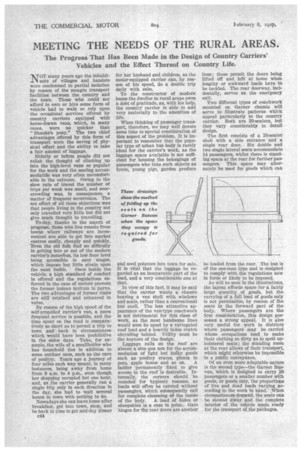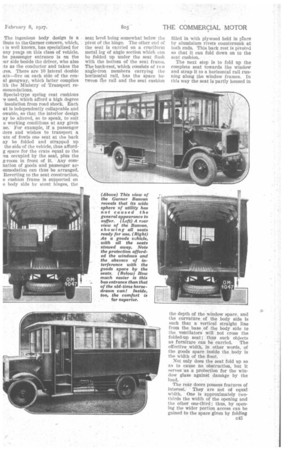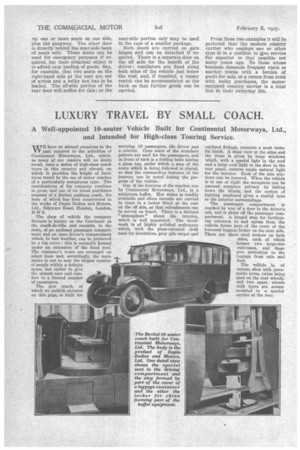MEETING THE NEEDS OF THE RURAL AREAS.
Page 110

Page 111

Page 112

If you've noticed an error in this article please click here to report it so we can fix it.
The Progress That Has Been Made in the Design of Country Carriers' Vehicles and the Effect Thereof on Country Life.
'MOT many years ago the inhabit.1.11 ants of villages and hamlets were condemned to partial isolation by reason of the meagre transport facilities between the country and the town. Those who could not afford to own or hire some form of vehicle had to walk or rely upon the occasional services offered by country carriers equipped with horse-drawn vans, which, in many cases, were no quicker than " Shanks's pony." The two chief advantages offered by this form of transport were the saving of physical effort and the ability to take a fair amount of luggage.
Elderly or infirm people did not relish the thought of climbing up Into the high-level vans so popular for the work and the seating accommodatidn was very often uncomfortable in the extreme. Owing to the slow rate of travel the number of trips per week was small, and overcrowding was, in consequence, a matter of frequent occurrence. The net effect of all these objections was that people living in the country not only travelled very little but did not give much thought to travelling.
To-day, thanks to the march of progress, those who live remote from towns where railways are inconvenient are able to get into market centres easily, cheaply and quickly. Even the old folk find no difficulty in getting into or out of the modern carrier's motorbus, its low floor level being accessible in easy stages, which impose but little strain upon the most feeble. Once inside the vehicle, a high standard of comfort Is offered and the regulations enforced in the case of motors prevent the former human multurn in parvo. The two advantages of former times are still retained and enhanced in value.
By reason of the high speed of the self-propelled carrier's van, a more frequent service is possible, and the time spent on the road is comparatively so short as to permit a trip to town and back in circumstances which would have been prohibitive In the olden days. Take, for example, the wife of a smallholder who has household ties In addition to some outdoor ones, such as the care of poultry. Years ago a journey of four miles each way meant, in many instances, being away from home from 9 a.m. to 4 p.m., even though her shopping occupied but one hour, and, as the carrier generally ran a single trip only In each direction in the day, she had to wait several hours in town with nothing to do.
Nowadays she can leave home after breakfast, get into town, shop, and he back in time to get mid-day dinner c44 for her husband and children, as the motor-equipped carrier can, by reason of his speed, do a double trip daily with eake.
To the constructor of modern buses the dweller in rural areas owes a debt of gratitude, as, with his help, the country carrier is able to add very materially to the amenities of life.
When thinking of passenger transport, therefore, we may well devote some time to special consideration of this aspect of the problem. It is important to remember that the popular type of urban bus body is rarely ddeal for the carrier's work, as the luggage space available is not sufficient for housing the belongings of passengers who take such objects as fowls, young pigs, garden produce
and seed potatoes into town for sale. It is vital that the luggage be regarded as an inseparable part of the load, and a very considerable one at that.
In view of this fact, it may be said that the carrier wants a chassis bearing a van shell with windows and seats, rather than a conventional bus sneil. The less attractive appearance of the van-type coachwork is not detrimental for this class of work, as the most handsome lines would soon be upset by a variegated roof load and a heavily laden cratch obtruding behind. Utility must be the keynote of the design.
Luggage rails on the roof are almost a sine qua non for the accommodation of light but bulky goods such as poultry crates, plants in pots, apple boxes and so on. A ladder permanently fixed to give access to the roof is desirable. Internally, the corners should be rounded for hygienic reasons, as loads will often be carried without passengers, which subsequently call for complete cleansing of the inside of the body. A load of hides or sheepskins is a case in point. Gate hinges for the rear doors are another item; these permit the doors being lifted off and left at home when lengthy or awkward loads have to be tackled. The rear doorway, incidentally, serves as the emergency exit.
Two different types of coachwork mounted on Garner chassis will serve to illustrate patterns which appeal particularly to the country carrier. Both are 20-seaters, but they vary considerably in detail design.
The first consists of a 20-seater shell with a side entrance and a single rear door. Six double and two single lateral seats accommodate 14 passengers, whilst there is standing space at the rear for further passengers. This space may alternately be used for goods which can be loaded from the rear. The bus is of the one-man type and is designed to comply with the regulations now in force or likely to be imposed.
As will be seen in the illustrations, the layout affords space for a fairly large quantity of goods, but the carrying of a full load of goods only is not permissible, by reason of the seats in the forward part of the body. Where passengers are the first consideration, this design possesses a strong appeal. It is also very useful for work in districts where passengers may be carried whose occupations tend to make their clothing so dirty as to spoil upholstered seats; the standing room at the rear allows of their transport, which might otherwise be impossible In a public conveyance.
Of an even more adaptable nature is the second type—the Garner Busvan, which is designed to carry 20 passengers or a smaller number with goods, or goods only, the proportions of live and dead loads varying according to the work in hand. When circumstances demand, the seats can be stowed away and the complete interior of the vehicle made ready for the transport of the packages.
The ingenious body design is a ibute to the Garner concern, which, is well known, has specialized for any yens on this class of vehicle. he passenger entrance is on the ar side beside the driver, who also ;ts as the conductor and takes the tres. There are 10 lateral double ats—five on each side of the cenal gangway, which latter complies ith the Ministry of Transport remmendations.
Special-type spring seat cushions 'e used, which afford a high degree insulation from road shock. Each at is independently collapsable and owable, so that the interior design ay be altered, so to speak, to' suit e working conditions at any given TIC. For example, if a passenger iters and wishes to transport a ate of fowls one seat at the back ay be folded and strapped up the side of the vehicle, thus afford g space for the crate equal to the .ea occupied by the seat, plus the g-room in front of it. Any cornnation of goods and passenger acimmoclation can thus be arranged. Reverting to the seat construction,
e cushion frame is supported on e body side by stout hinges, the
Seat level being somewhat below the pivot of the hinge. The other end of the seat is carried on a cruciform metal leg of angle section which can be folded up under the seat flush with the bottom of the seat frame. The bark-rest, which consists of two angle-iron members carrying the horizontal rail, has the space between the rail and the seat cushion
filled in with plywood held in place by aluminium rivets countersunk at both 'ends. This back rest is pivoted so that it can fold down on to the seat cushion.
The next step is to fold up the complete seat towards the window and strap it to a horizontal rail running along the window frames. In this way the seat is partly housed in
the depth of the window space, and the curvature of the body side is such that a vertical straight line from the base of the body side to the ventilators will not cross the folded-up seat; thus such objects as furniture can be carried. The effective width, in other words, of the goods space inside the body is the width of the floor.
Not only does the seat fold up so as to cause no obstruction, but it serves as a protection for the window glass against damage by the load.
The rear doors possess features of interest. They are not of equal width. One is approximately twothirds the width of the opening and the other one-third; thus, by opening the wider portion access can be gained to the space given by folding
up one or more seats on one side, plus the gangway. The other door is directly behind the near-side bank of seats only. These doors can be used for emergency purposes if required, but their principal object is to afford easy loading of goods. Say, for example, that two seats on the right-hand side at the rear are out of action and a bulky box has to be loaded. The off-side portion of the rear door will suffice for this; or the near-side portion only may be used In the case of a smaller package.
Both doors are carried on gate hinges and can be detached if required. There is a separate door on the off side for the benefit of the driver ; ventilators are fixed along both sides of the vehicle just below the roof, and, if required, a roomy crutch can be accommodated at the back so that further goods can be carried. From these two examples it will be gathered that the modern country carrier who employs one or other type is in a position to give service far superior to that possible not many years ago. To those whose business demands frequent visits to market towns with a burden of goods for sale, or a return from town with bulky purchases, the motorequipped country carrier is a vital link in their everyday life.




































































































































































































